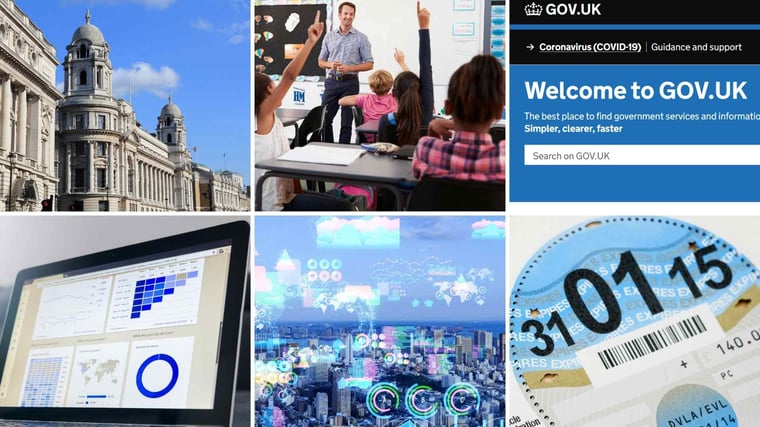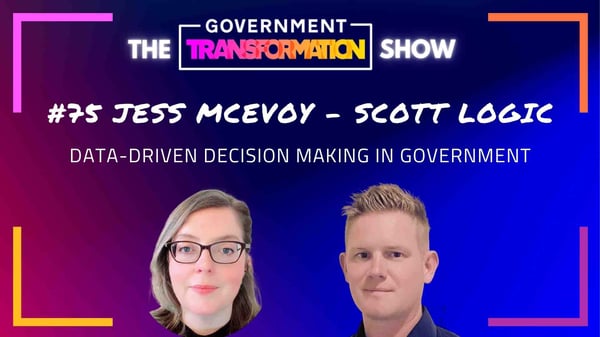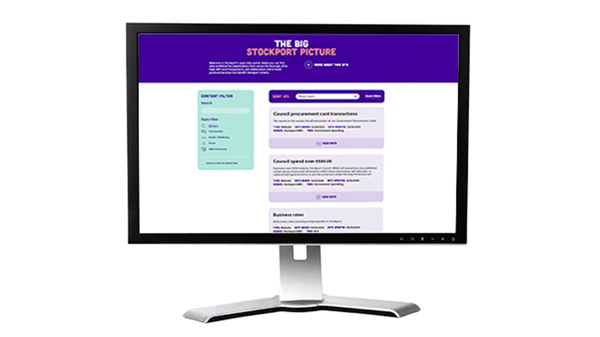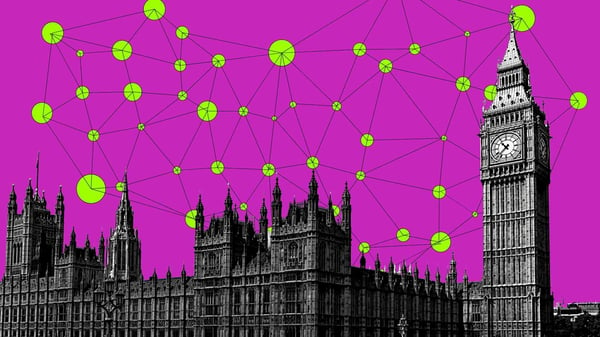The essential guide to data-driven government

With so many government organisations deploying data-powered decision-making, it’s important to understand what we mean by the concept and how to get it right.
In this essential guide to data-powered government,we'll explore the evolution of data-driven policy-making, explaining what it takes to make the most of the opportunity and identify five key pillars that should be in place to deliver effective, data-driven government policy and decisions.
What you'll learn
Foundations of effective government data governance
Benefits of best practice in government data
Government data in action: case studies
The evolution of data-driven government
Why government data matters
Without data, it’s impossible for government and public sector organisations to make evidence-based decisions. Data underpins government decision-making and consequently underpins the way we live our lives. How public sector agencies use data can have direct implications on whole-life issues like how we make provision for later life via healthcare and pensions, what prospects are for our jobs, our health and wellbeing, through to the educational attainment of our children. In the digital age, you can’t get government right if you don’t get data right.
Advances in technology have enabled us to collect far more data and process it at speeds that were impossible as little as four years ago. That acceleration of pace places corresponding pressure on the principle of effective data governance and management.
As David Wilde, GovX Digital’s GM for Government says: “All too often, we end up with bad data that needs cleaning - a process that’s expensive, laborious and painful. I've said for 30 years in government that information governance and data governance may be boring, but they’re essential. We have to get it right, because the consequences of getting data wrong in turn lead to bad decision making, which in turn can have dramatic consequences on people’s lives.”
What’s the problem you’re trying to solve with government data?
It’s essential that people understand what the problem is they're trying to solve, then build their evidence around it. With that purpose in mind, you can identify the right information, make information-sharing protocols easier, and make the destination clearer. What you can't do is collect a lot of data and then see what the problems are - that’s the wrong way round. You'll find yourself with an awful lot of data and get very confused, very quickly.
Don't be closed-minded about the route through which you can solve it. Frame the problem in a way in which you can then gather evidence to do something systematically. For instance, take the issue of knife crime. If you ban knives, it doesn't get rid of knife crime. The root cause behind it is explored through the broader socio-economic conditions - gang culture and related issues - which means your intervention won’t be as simple as possible legislation. Don't prejudge the outcome - the value of data will then help you formulate solutions.
Foundations of effective government data governance
WATCH: 5 pillars of effective data governance 📺
Having established that open-minded approach to problem-solving, there are then five key factors that will make these things work - or not.
1. Knowing what data exists
All organisations should now have Information Asset Registers as part of GDPR. If they haven't, they need to get them sorted. It's not just about compliance with GDPR, it's actually to let other organisations know what data you've got to begin with.
The reality is a mixed bag. A lot of organisations have perhaps logged three-quarters - it's certainly not a trivial undertaking. The challenge is with the smaller systems - it's easy to do the big systems like social care and patient care, but the challenge is in identifying and capturing the numerous peripheral systems in the public sector and understanding what data they hold. It’s harder to capture, yet potentially, it's that information that can be incredibly valuable.
2. Ensuring data quality in the public sector
We’re only as good as the quality of data we have. If you haven't got decent data quality, you can easily make very bad decisions. How do you know if your data is any good? That's the next challenge...
3. Understanding public sector data standards
As well as adhering to internationally recognised data standards, you need good discipline in teams to understand what good data is. So what is good data? As David Wilde says: "It's actually not complicated. Good data is the simple things like spelling the name of a town properly. I’ve seen IT systems with the name of Southend spelled five different ways! "
It’s significant to note that all of these first three pillars are driven by GDPR, emphasising its ongoing value for public sector organisations.
4 Following best practice in public sector data-sharing
It’s vital to put information-sharing agreements in place between public sector agencies. Referring back to my earlier point, if you've got a clear purpose, information-sharing agreements are easy. If you’re going fishing, information-sharing agreements are impossible. Guess what? Under GDPR, you can't go fishing, at least not in other people’s data lakes.
5. Building in data interoperability
Interoperability is what pulls all of these pillars together. By using systems that talk to other systems, through APIs, you can unlock new insights by overlaying and analysing different datasets. Underpinning that quest for interoperability needs to be an equal commitment to cloud-based systems in your public sector organisation.
The benefits of best practice in government data
.jpg?width=725&name=data%20driven%20government%20transformation%20(1).jpg)
These five things enable you to carry out effective information-sharing, develop strong data analytics and produce good quality data. Falling short on any of those five things can severely compromise your ability to deliver data-driven outcomes.
Use products that span those five principles, ensure your workforce understands the true implications of good and bad data, and you’ll be able to do some fantastic work with data and analytics.
Once you've got that right, then you can explore what the innovative technology does - your dashboards will work, they'll have good data behind them, and it will be quality information that you can render and provide for your teams.
The beauty of the analytics capabilities we have now is they've become simplified and easy to use - you don't need statisticians to do it for you. Now you can buy products that can share that information widely, and can render it quickly and visually.
There are huge opportunities around data and GIS. The geospatial systems and the interoperability we now have mean you can render information in a spatial or geographic context in a way that you couldn't imagine doing 10 years ago. There's so much more we can do in that space, helping people visualise how where we live can look differently in the future.
Government data in action: case studies
HMRC’s furlough scheme
As the Covid pandemic forced thousands of businesses to halt or radically scale back operations, HMRC’s Coronavirus Job Retention Scheme, commonly known as the furlough scheme, was launched in a matter of weeks to support employers in paying staff and retaining their jobs as an alternative to mass redundancies. It launched in March 2020 and by June 2021 had paid out claims to cover 11.6 million unique jobs in the UK economy.
HMRC designed and launched the online application portal connected to existing PAYE and tax data to allow employers to:
- Check claim eligibility.
- Check which employees they could put on furlough.
- Calculate how much they could claim.
- Submit claims.
As of June 2021 the Coronavirus Job Retention Scheme had paid £35.4bn to businesses to support wage payments.
Estonia’s digital identity scheme
Estonia is widely regarded as a global leader in digital and data-driven government, topping the most recent United Nations E-Government Index. Estonians receive their state-issued digital identity at birth, and currently it’s estimated that 98%+ of the Baltic state’s citizens have one. As well as proof of identity, the digital card (which can also be accessed via a mobile phone SIM card) allows Estonians to engage in a wide range of services and activities, including:
- Providing digital signatures
- Online voting validation
- Travelling public transport in major cities
- Accessing medical records,
- Submitting tax returns and claims.
- Medical Prescriptions
- travelling within the EU
- Accessing to health insurance
- Logging into bank accounts
Predicting school readiness in Essex children
This cross-agency partnership used predictive analytics across datasets from different public agencies to identify and predict the likelihood of young children being ‘school-ready’. The results of the Essex Data Programme allowed agencies to offer targeted support and intervention for those most likely to need it.
Working within the Cabinet Office’s Data Science Ethical Framework, data from Essex County Council, Basildon Borough Council and Essex Police was pseudonymised at source and matched at household level to generate community-level insights about areas of Basildon where school readiness issues were most likely to be present.
Those insights were then triangulated using predictive risk models to produce recommended changes and interventions that would enable a ‘best start in life’ for children and improve their readiness to enter education.
Digital transformation of DVLA
The digitalisation of the Driver and Vehicle Licensing Agency’s operations was a huge undertaking given the amount of data and paper-based records that existed - it's regarded as a flagship project in the UK Government's digital transformation programme..jpg?width=200&name=Untitled%20design%20(1).jpg)
A significant data cleansing exercise was needed to resolve the prevalence of out-dated records - it was estimated that there were more ‘live’ paper driving licences in the UK than adults when the process began.
The project involved a comprehensive digital-first review of DVLA services, delivering outcomes that included:
- The replacement of ‘paper counterpart’ to record a driver’s points and endorsements with a new online recording tool.
- The Register a Vehicle (RaV) service allows manufacturers and dealers to register brand new vehicles via a portal on GOV.UK
- Replacement of paper tax discs in cars with an online register
- The online vehicle enquiry service, allows the public to check if a vehicle is taxed and has an MOT
How data-driven government evolved from evidence-based policy formulation
Going back 20 years, one of the big flavours in government used to be evidence-based policy formulation. Before we had the kinds of tech and analytics we have these days, evidence-based policy formulation came from the right place, which is, how do we know policies we’re developing are grounded in sound information and data?
The driver behind evidence-based policy formulation was to get that information to drive government’s thinking about where to put big investments.
One of the best examples was what the UK government of the day did with the regeneration of the town of Consett after the closure of the British Steel works in 1980 - a one-industry town where unemployment went through the roof. The government created a taskforce from across Whitehall to come up with answers to how we could turn around a failed town in its most fundamental sense. What came out of it was a combination of inward investment, direct subsidy, reskilling and retraining on a huge scale, as well as deep interventions in supporting families in crisis.
It was a great, coherent piece of work that had long-term significance. Why is that important for data and data-driven decision-making? In Consett, there was a plan put together that had a destination in mind - that by creating a diverse economy, this place will not fall back into the same trap again. It was fascinating to see how that improved and helped the lives of those people in that town.
The Neighbourhood Renewal Programme in the early 2000s was another great example of a government of the day getting agreement from other opposition parties. The whole idea around neighbourhood renewal with cross-party consensus was to identify the most deprived parts of the UK, understand the causes, then come up with answers to tackle that deprivation in a systemic and sustainable way. It was driven by collecting the data first to understand what the problems were, looking at root cause analysis, and then putting in place interventions to help turn those places around.
Neighbourhood renewal captured evidence from the 88 most deprived wards in the UK, then understood the data and the analytics around what happened in their history. Then the government created a programme of work targeted around those particular localities, working with local government. To this day, it stands as one of the best examples of what I would call evidence-driven decision-making and policy formulation.
More recent examples are more like pilot projects. In Essex, we did some work as a County Council around identifying methods to spot where children are not fit or ready for school. We gained understanding of the reasons for deprivation by working with communities to understand what the drivers were preventing children under three developing to a position that they’re school-ready.
The evidence developed through conversations and engagement with the families, combined with other public sector information-sharing agreements.







